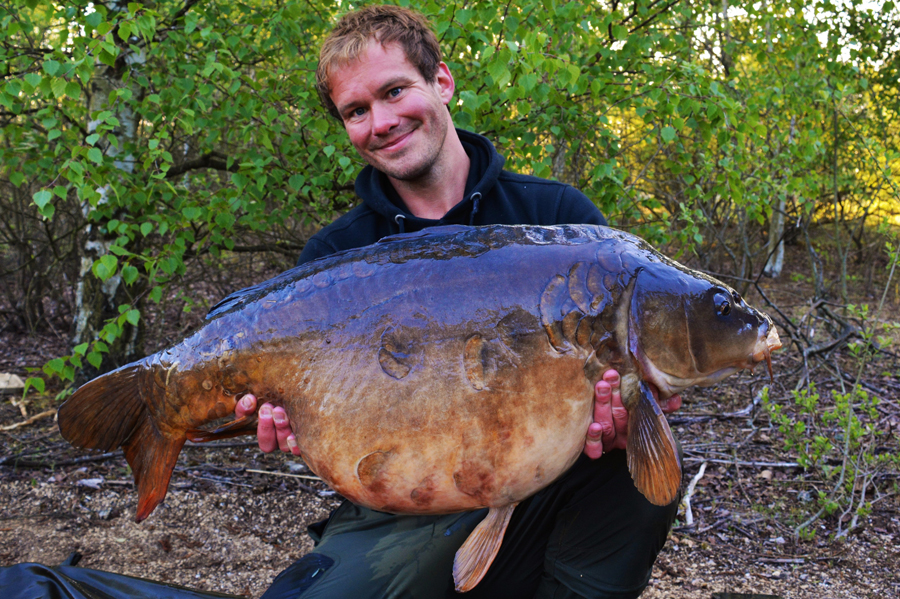27 сентября, 2017 | Carp | Tips | Articles | News
0 CommentsPre-baiting is a trick anglers have used for years to bring fish in, but Wayne Iszatt uses pre-baiting to clear as well as draw…
What bait do you use for baiting up?
Most anglers’ answer to this question will be ‘the boilie I intend to use as hookbait’, but can we do better than this?
Most of my fishing is done on clear, weedy gravel pits with many diving birds, so baiting strategy requires careful consideration if I want it to be successful. Obviously, other types of waters like rivers may need a varied approach to this, but for large, weedy clear pits, you may find some of my conclusions useful.
The first goal I am trying to achieve in my pre-baiting is to provide a clean spot on the lake bed for me to present a hookbait without having to worry about weed or debris possibly fouling the hook point. If you are using just whole boilies then the process of ‘cleaning the bottom’ will take much longer compared to baiting up with smaller items. If the carp don’t visit your spot to feed pretty quickly, you may find the birdlife will annihilate your bait anyway, meaning it was a total waste of your time and money. So, to combat this, it is highly beneficial to bulk your feed with low visibility and small food items. Remember, the smaller the items, the less energy efficient it is for the birds to dive on your spot, which will encourage them to move on to another food source, or at least there will still hopefully be some leftovers for when the fish do move in.
What Baits to use?
Think carefully about what you introduce to your ‘baiting up’ mix to maximise its worth. These are the baits currently in my ‘Camo’ mix and the reasons why:
- Boilie — If you intend to use boilies as a hookbait, it is a good idea to have them in your feed, however I chop and crumb the bulk of mine for three reasons:
- This will make them harder to find and pick up to the birds, so less energy efficient for them to dive for.
- The fish will have to dig and sieve for your baits, resulting in the bottom being cleaned off quicker and so holding the fish on the spot to feed for longer, great during those times you have a got a rig on the spot.
- This will stop the baits rolling away, if your spot is on a slight slope.
Then, there is the decision on what boilie to use.
If you are fishing clear water and you want productive pre-baiting, then in my experience it has to be dark and ‘pastel-coloured’ boilie if you want to reduce the bird annihilation. I am currently using CompleX-T and that blends into the sand and gravel bars pretty well.
- Frenzied Hemp — I would not tackle a weedy water without this stuff. It’s by far the best bait to get the bottom cleaned off the quickest in my opinion and also too small and low-vis for the birds to bother with. Hemp usually makes up around 50 per cent of my baiting up mix when I begin work on a spot and once it has been cleaned off, I will reduce this somewhat, as its purpose has been served.
- Pellet — I choose to put this in my mix for its hi-attract and low visibility properties. Swim Stim a Betaine Green pellet that is great to blend in with weedy spots, whilst the Amino Original pellet range is perfect for matching up over sand and/or gravel bars.
- Groundbaits — Because I rarely use high visibility baits for baiting up due to the above reasons, I bulk my feed with groundbait to punch out the attraction and smell and hopefully draw the fish down if they are high up in the water. My favourite ground baits for this in the warmer months are the Green Lipped Mussel and Marine Halibut, which I mix 50:50 to create a colour that blends well with most lake beds and doesn’t act as a beacon for the birds.
These groundbaits really do pump out some smell and oil, a real confidence booster in anyone’s book. This groundbait is also a great advantage once you do have a rig out and feeding begins, as it clouds up the spot instantly as it floods back out their gills, which hides your ‘trap’, increasing your chances even further.
I have found this to be a big edge when stalking in the margins, as I can literally lower the rig amongst feeding fish in the cloud of groundbait without spooking them, and in that low-visibility situation it is often only moments before the rod bursts into life.
- Monster Tigers — These are a good option to add (as long as fishery rules allow) if the spot is gravelly and already clean, as they should then blend in well. It also allows you another hookbait option if the birds are picking you up and removing the hookbaits, as tigers are very durable.
- Salt — I mix this into my groundbait blend too. I use table salt, as I believe this does not fully dissolve, therefore the carp should be getting little hints of it as they sieve through the bait. Also, they love the stuff, in fact, for most of the year, especially throughout the warmer months, I believe they crave it.
- Liquids — Dousing your mix in the liquid to match your boilie will again send out the food signals that compliment your hook bait, another edge I’ve used to good effect over the years.
Application:
Rather than concentrate pre-baiting one spot with a large amount, I would much rather split that same bait over three or four spots around the lake. This way you give yourself options to fish to according to conditions, angling pressure and sightings of carp on your sessions.
Using a carpet mix of small items for baiting up, you will find you don’t need a great deal of ‘bait hits’ before the spot is clean enough for a rig, providing the carp have fed on the spot. This will be visibly evident if some of your spots are in the margins.
How much you apply is up to you and also dependant a little on the amount of nuisance fish. Personally, I rarely put more than one kilo on each spot at a time. I feel regularity is more important than quantity, as I am hoping that the fish will find some bait on my spots often enough to start including them into their regular feeding patrol. I would rather spread the spots across the pit and have lots of small dining tables, rather than one large one, as then one at least is likely to get results, or hopefully all of them. If that’s the case, they can then be fished on rotation, as it often doesn’t take long for a spot to ‘blow’ once it has claimed a few captures. If this happens, I like to rest the spots after a bite or two and then give them some free feeds for a while to keep their confidence up, whilst I fish another spot.
Feeding times
It is worth taking note of what areas of the pit do bites at what time of day and trying your best to bait accordingly. For example, the areas that are good for a night bite, try to bait up these as late in the evening as you can to help make sure that the bait is still there when the carp show up. Conversely, for waters with ‘day form’, in that case it may be worth an early rise before work.
Where to pre-bait?
Firstly, don’t ignore the margins. Carp will always like patrolling them as they offer a point of interest and often extra food from the undertow or wind. I believe it is only when they have a feeling of un-ease that they won’t get into the edge. So, if there are any areas of the lake that don’t see a lot of noise or human interference and have ‘natural sanctuary’ of some kind, then it will be a fair bet the fish won’t be too far away.
For fishing at longer range, a study of the topography with the marker float is a real advantage. The top of a clean gravel bar for instance can produce bites of course, however, I would personally be fishing at the bottom of the bar as that’s where all the free bait will end up once feeding begins, or even just from the undertow, leaving your blatant single sat there alone on the top of a bar, which is an obvious trap to a wised-up carp.
I don’t look for clear spots either when starting pre-baiting, as this could have been another angler’s spot that could have blown and the fish now avoid. So, I will look for low weed with a gentle thud on the drop of a lead. This will indicate a hard bottom beneath the weed and not an indent full of soft, smelly silt that they may be reluctant to feed on.
So, once I have found the potential hard spot, I will then bait it and get it polished up.
If you have your mind set on a desired fish then it is well worth baiting up areas you know of previous captures, as carp do seem to have their routines, which will include preferred feeding zones.
All you have to do now is catch them!
Wayne Iszatt




















No comments, start a conversation and make a comment?